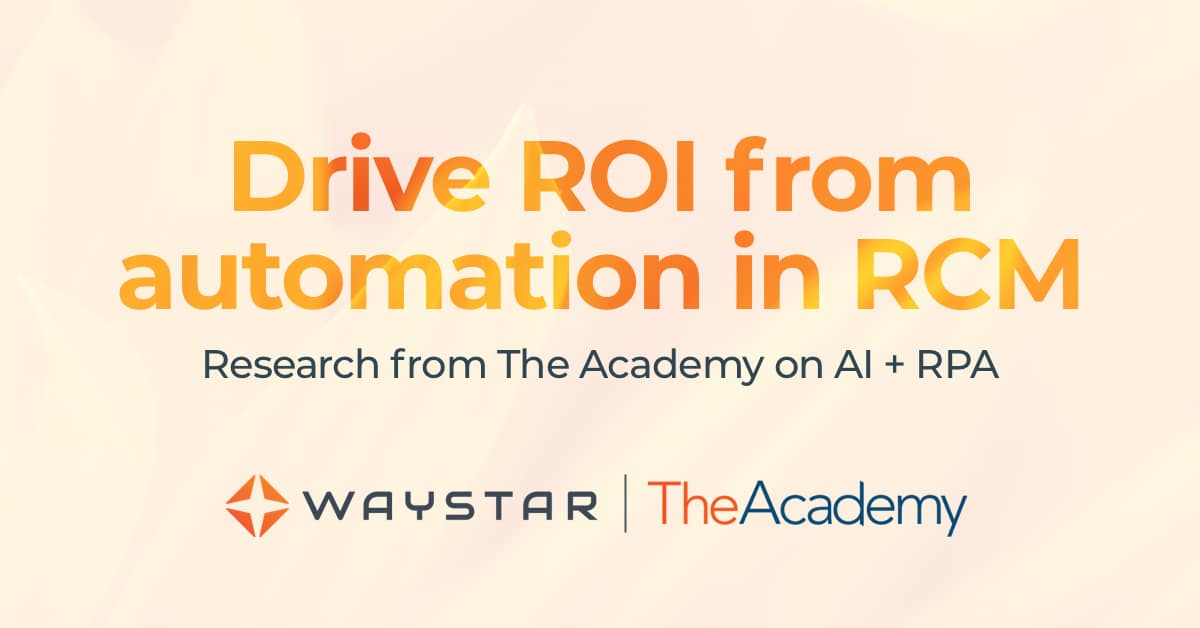
MEASURING BENEFITS BEYOND ROI
Recent years have brought new challenges for healthcare revenue cycle management (RCM) leaders. CFOs and VPs have high hopes for technologies — such as automation and artificial intelligence (AI) — to impact the bottom line. But automation can do so much more. Healthcare leaders who adjust their mindset to consider all the benefits of automation will have opportunities to make workforces more efficient and retain talent for the long haul.
Automation in healthcare
“Across the board, across all different health system leaders, organizations are thinking about adopting or scaling automation of some sort — it is a very high priority,” said Anne Herleth, principal of Research + Advisory at The Health Management Academy.
The organization recently surveyed 50 of its member health systems with net patient revenue of $2 billion or more on automation and AI in healthcare RCM.
“We found almost a majority (45%) were either currently using or evaluating the use of robotic process automation (RPA) and AI in the revenue cycle,” Herleth said. “At some point, the healthcare industry will probably be using technology across most parts of the revenue cycle with the support of the RCM workers.”
Benefits of automation + AI beyond ROI
In the survey, healthcare executives that already use automation and AI for at least one part of the revenue cycle reported a lower-than-expected return on investment (ROI). On a scale of 1 to 5, the average perceived ROI was 2.21.
Despite those numbers, 82% noted cost reduction as a major benefit and 74% saw increased revenue capture.
However, efficiency was the biggest boon of automation, noted by 91% of surveyed health systems that already use the technology. Looking beyond obvious ROI benefits, executives reported reasons to invest in automation and AI:
- Workforce efficiencies
- Employee satisfaction
- A competitive advantage
- Better support value-based care reimbursement
- Relief for specific RCM pain points (like authorization denial)
On the topic of workforce efficiencies, one surveyed health system revenue cycle VP said:
“Have we been able to reduce staff at this point? No. Do I think at some point we will? Yes. The bigger piece is we haven’t needed to add staff as we grow.”
Herleth noted, “Organizations that invested in automation for revenue cycle did not end up eliminating revenue cycle positions but rather reallocated staff to a different type of position. This is critical at a time when staff is hard to come by.”
Strategies for successful automation
For health system leaders looking to automate their RCM process for greater efficiencies, open communication with their technology partner is key early on in the process.
“Starting the project off with being very clear on both sides starts to establish trust,” said Heather Kawamoto, vice president of Product Strategy at Waystar. “Be clear on expectations of timing and have a discussion about the best-case and worst-case scenarios. Share if you don’t have that many IT resources available or if revenue cycle automation implementation is a lower priority than other system projects. Solving for that early on is important.”
After the rollout, successful automation typically requires ongoing collaboration as the revenue cycle staff changes and adopts the processes. Based on the study’s findings and Waystar’s experience, here are a few strategies to consider as you move forward with automation:
- Adjust your leadership mindset. Automation and AI are unlikely to fully replace the human workforce. Leaders can focus on opportunities to augment current work.
- Level-set automation and AI expectations. Work closely with your technology partner to learn the realities of what automation can and can’t do and plan staff accordingly.
- Broaden your definition of success. Consider soft metrics like more engaged staff who are more excited to work and less likely to turn over in addition to hard metrics, such as cost savings, operational efficiencies, and FTE reductions.
- Get staff buy-in. Acknowledge staff reservations around new tech such as ‘Will I be replaced?’ Clearly communicate intentions, such as potential changes to existing roles.
- Redesign staff roles. Work with chief human resource officers and department leads to assess potential impacts on staff roles and create workforce adjustment strategies.
- Invest in training. Give your staff the knowledge to optimally use the technology so both the users and your organization can benefit from automation and AI.
“As you’re starting to have conversations with potential partners, ask, ‘What are those partners doing to anticipate where the market is going above changes to the technology?’” Kawamoto encouraged. “The market is changing. Reimbursement models are changing. The way care is delivered is changing. There are going to be impacts on technology. You want a partner that has a pulse on all those changes.”
Solutions for the revenue cycle
Waystar offers revenue cycle automation solutions for health system executives looking for an all-in-one revenue cycle management platform or who need to elevate their existing systems. We’re always searching for new and better ways to solve your challenges.
Find this post helpful? Check out our webinar about impactful automation to learn more about how automation can help you.






